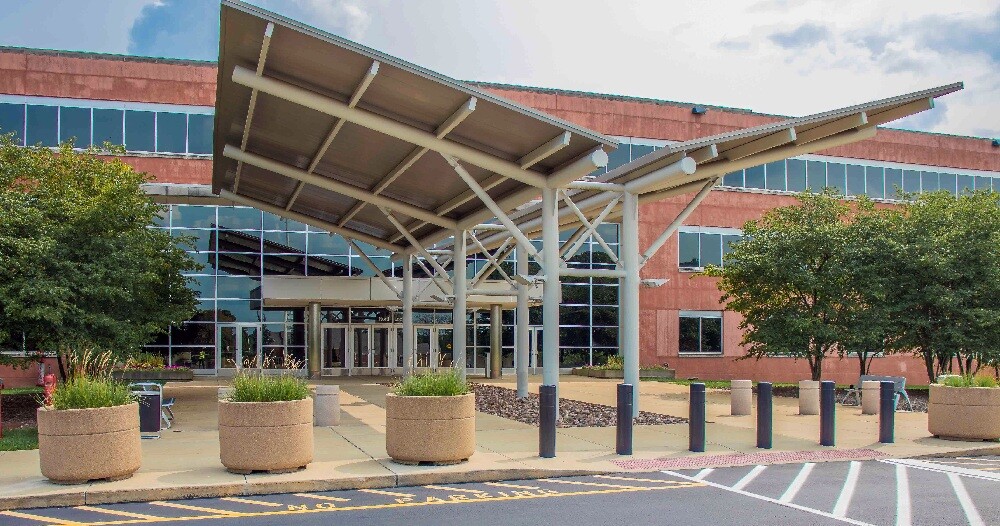Ballistic curtain walls are effective for creating secure segments or areas of a building, a key protective measure for active shooter situations. Full-glass curtain walls can work for interior or exterior applications and can span multiple stories.
You might see a bulletproof curtain wall of windows to funnel passengers through security in airports or as a freestanding protective barrier in historic buildings with alteration restraints. Other industries that rely on highly aesthetic bullet-resistant curtain wall protection include corporate offices, government buildings, and banks.
What Architects Need to Know about Bulletproof Curtain Walls
While a ballistic curtain wall can provide a gorgeous barrier of protection that matches nearly any building aesthetic, this style of facade does have some serious design considerations.If a curtain wall facade is the right bullet-resistant protection for your project, here are four key things you need to know.
1. You’ll Need to Consider the Bulletproof Glass’ Thickness and Weight
The greatest design challenge for any bulletproof glass project is accommodating the weight and thickness of the ballistic glass. A protective curtain wall may be 2 to 8” deep. Ballistic glass that is used in a curtain wall, depending on its protective rating, is likely to be up to 1½” thick, and weigh 8 to 11 pounds per square foot.
Depending on the height of the curtain wall, your design may need intense structural reinforcement. This is especially true for exterior applications that need to account for wind loads. Heavy stresses require a robust structure. Structural warping or failure can quickly compromise the integrity of bullet-resistant glass systems.
If you’re working on a bullet-resistant curtain wall project, contact your bulletproof glass vendor to understand the specs of the materials before getting started on the design. When you work with TSS, our team of engineers can help you determine the specific support needed for your design.
2. Bulletproof Glass Has Limited Sizing Options
Bullet-resistant glass panes are limited in size by the autoclaves used in the glazing fabrication process. Ballistic glass’ width is typically limited to 6 feet. When designing a curtain wall, factor this constraint into the design, or talk to a ballistic glass expert to see if there are ways to make your design look seamless.
3. Large Panes of Some Types of Bulletproof Glass May Warp
Most architects have a lot of experience with tempered glass, which undergoes almost no warping. Bullet-resistant glass is a different experience. Due to the bulletproof glass lamination processes, an 8-foot length of glass can experience ¼” to ½” of warping. This is true of any laminated glass product. If your design involves large panes and a seamless design, this can accentuate the distortion and detract from the aesthetic appearance.
While a difference of ¼” might be critical for your project, with fully-framed glass, any warping is almost unnoticeable to users. TSS uses a gasket and wedge framing system to provide a protective seal that disguises any inherent waviness in the glass.
4. Use the Right Products to Achieve Energy Efficiency
Architects often have to achieve a certain energy efficiency in their design, whether due to compliance with LEED-certification or other local requirements.
Insulated bullet-resistant glass and framing systems can provide numerous design benefits, using an air gap to create a thermal break. This energy-efficient product is great for both high and low temperature environments. At TSS, our bulletproof glass can also be customized with tinting, low-E, and other solutions tailored to your aesthetic or design requirements.
Keep in mind this is a specific product with insulative properties. Other types of bulletproof glass are not designed to provide thermal benefits.
Get the Details Before You Start Designing
When designing a bulletproof curtain wall, the variations in different bullet-resistant glass products can really affect the design considerations for your project. One of the best steps you can take is to talk to a ballistic glass expert about your goals and your vision, so they can help you understand feasibility and cost-effectiveness of the materials.
Our team has experts standing by, ready to deliver the material specs and any other important details that could affect your project. We want to help you make your vision a reality, while maintaining a complete and secure protective barrier system. After all, Safety + Aesthetics™ is our specialty.
For more information about the properties of bulletproof glass, download the free Ballistic Glazing Solutions Guide. Or, if you’d like to talk to a security expert about your project, just contact us here.

